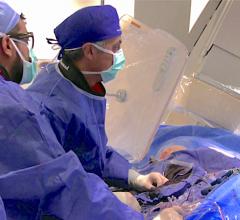
August 1, 2023 — Viz.ai, a leader in AI-powered disease detection and intelligent care coordination, announced the presentation of three new abstracts that demonstrate the real-world impact of the Viz Neuro Suite at the Society of Neurointerventional Surgery (SNIS) Annual Meeting. These independent studies demonstrate the clinical, health equity, and patient benefits of AI-driven technology, and reiterate Viz.ai’s commitment to transforming patient care.
A study from HCA Houston Healthcare, “Viz LVO versus Rapid LVO in Detection of Large Vessel Occlusion on CT Angiography for Acute Stroke,” by Delora et al., highlights the superior performance of the Viz LVO solution in detecting suspected large vessel occlusion on computed tomography (CT) angiography for acute stroke. The findings underscore the critical role of Viz.ai's advanced AI algorithms in accurately identifying and triaging patients for prompt intervention, ultimately improving outcomes and saving lives.
"Accurate early detection of stroke using the Viz.ai stroke platform significantly improved our team communication and resulted in improved overall stroke metrics," said Dr. Mohamad Ezzeldin, neurointerventional surgeon, director of CNS Neuroendovascular Surgery and Stroke Medical Director for HCA Houston Healthcare Kingwood and study investigator. "The Viz.aiplatform has become an invaluable tool in our practice, and I rely on it when I’m on call."
An abstract from the University of Kentucky, “Rural Versus Metropolitan Stroke Activation Incidence: Using Viz.ai To Determine Disease Penetrance,” by Fraser et al., demonstrates the value of data to visualize the level of disparities in care and redistribute resources to increase access to stroke care in rural areas. By leveraging AI technology, Viz.ai enables healthcare providers to bridge geographical gaps, ensuring equitable access to time-critical interventions for stroke patients, regardless of their location.
“Rural areas of Kentucky - particularly in Appalachia - are known to have increased risk factors for major diseases. We are using this technology as a bridge into local communities with high incidences of stroke,” said Dr. Justin Fraser, lead investigator. “These findings provide confirmation of the importance of stroke care protocols in rural areas and the value of fast identification and triage for these communities.”
Data from Valley Health System, in an abstract titled “Radiographic and Clinical Outcome-Based Assessment of Middle Meningeal Artery Embolization for Chronic Subdural Hematoma Patients at a Community Hospital,” by Altschul et al., explores the successful implementation of Viz.ai's AI-powered solutions to assess and treat chronic subdural hematoma patients. By enabling precise radiographic analysis and clinical outcome assessment, Viz.aiempowers community hospitals to deliver enhanced care to patients with this complex condition.
"It was remarkable to have the ability to educate patients about their disease at the bedside and show patients their scans with volume measurements,” said Dr. Dorothea Altschul, director of Neuroendovascular Surgery at Valley Health System and lead investigator. “We used this tool not only for care coordination but also for care education.”
"These results further demonstrate the impact of AI-powered care coordination and the unparalleled accuracy and seamless implementation of Viz.ai in hospital systems," said Jayme Strauss, chief clinical officer at Viz.ai. "Through our innovative approach and close collaboration with top experts, we continue to advance neurovascular care, making a profound impact on patient outcomes."
For more information: https://www.viz.ai/neuro


 January 31, 2024
January 31, 2024 






